Scientists Discover Space’s Largest Intergalactic Bridge, Solving A Huge Dark Matter Puzzle
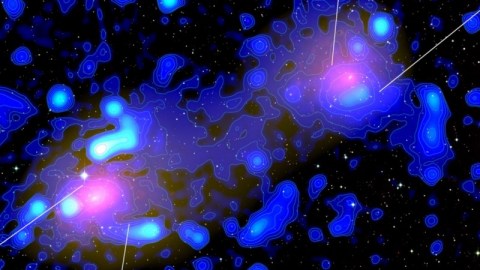
Dark matter’s naysayers latched onto one tiny puzzle. This new find may have solved it completely.
Imagine the largest cosmic smashup you can. Take the largest gravitationally bound structures we know of — enormous galaxy clusters that might contain thousands of Milky Way-sized galaxies — and allow them to attract and merge. With individual galaxies, stars, gas, dust, black holes, dark matter and more inside, there are bound to not only be fireworks, but novel astrophysical phenomena that might not show up elsewhere in the Universe.
The gas within these clusters can heat up, interact, and develop shocks, causing the emission of spectacularly energetic radiation. Dark matter can pass through everything else, separating its gravitational effects from the majority of the normal matter. And, in theory, charged particles can accelerate tremendously, creating coherent magnetic fields that could span millions of light-years. For the first time, such an intergalactic bridge between two colliding clusters has been discovered, with tremendous implications for our Universe.
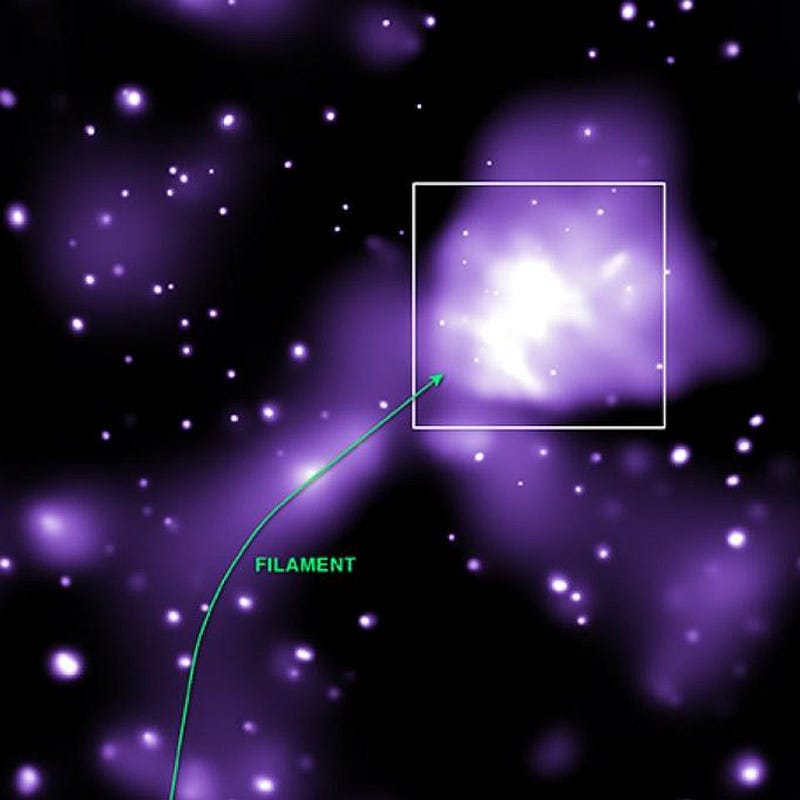
In our cosmos, astronomical structures aren’t all created equal. Planets are dwarfed by stars, which themselves are far smaller in scale than Solar Systems. Collections of many hundreds of billions of these systems are required to make up a large galaxy like the Milky Way, while galactic groups and clusters might contain thousands of Milky Way-sized galaxies. On the largest scales of all, these enormous galaxy clusters can collide and merge.
Back in 2004, two sets of observations came in concerning a pair of galaxy clusters in close proximity: 1E 0657–558, more commonly known as the Bullet Cluster. From an optical image alone, two dense collections of galaxies — the two independent clusters — can clearly be identified.

There are then two additional things you can do to tease out additional information about what’s going on in this system. One physically interesting measurement you can make is to look at the light from all the galaxies you can see in the image, and identify which ones are behind (background galaxies) the clusters versus which ones are in front (foreground galaxies) of them.
When you look at the foreground galaxies, their orientations should be random: they should be circular or elliptical or disk-like with no average distortion skewed to favor any particular direction. But if there’s a large mass in front of the light, there should be gravitational lensing effects that distort the background images. The statistical differences in shape between the background and foreground galaxies can tell you information about how much mass is located at various positions in space, at least from our point of view.
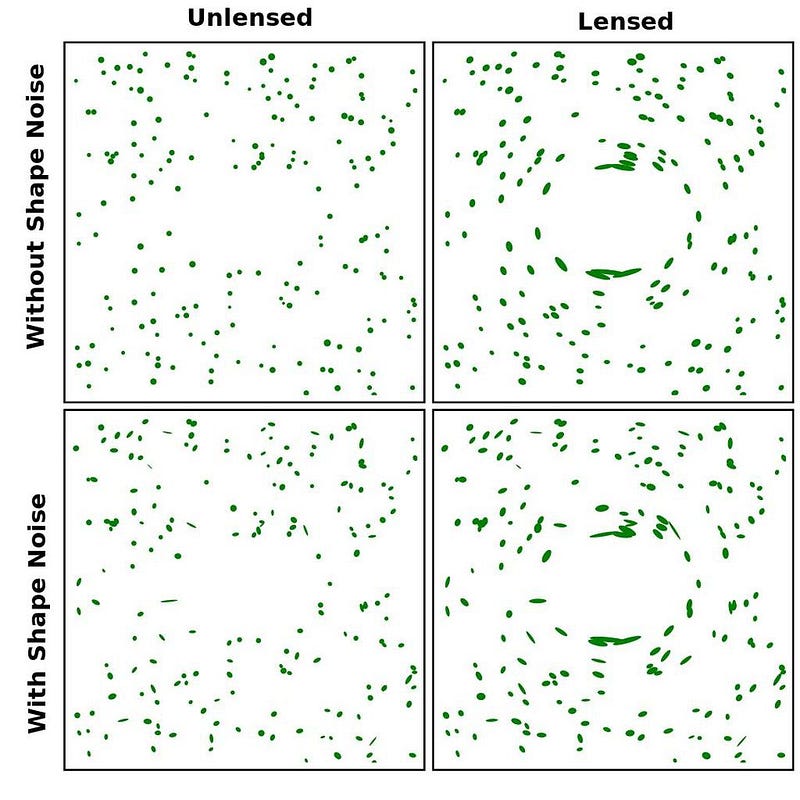
The second thing you can do is to observe the exact same region of the sky in X-rays, using an advanced X-ray observatory in space. Observations that were conducted with NASA’s Chandra X-ray observatory were sufficient to do exactly that. What Chandra discovered was fascinating: two enormous clumps of gas were spotted, each one moving along with its home galaxy cluster. As expected, there’s an enormous amount of gas not only associated with each galaxy, but with the overall cluster as a whole.
But what was unexpected was the finding that the gas, making up about 13–15% the overall cluster’s mass, was actually separated from the gravitational effects! Somehow, the normal matter and the gravitational effects were separated, as though the overall mass had simply passed straight through. This result was taken as overwhelming astrophysical evidence for the existence of dark matter.
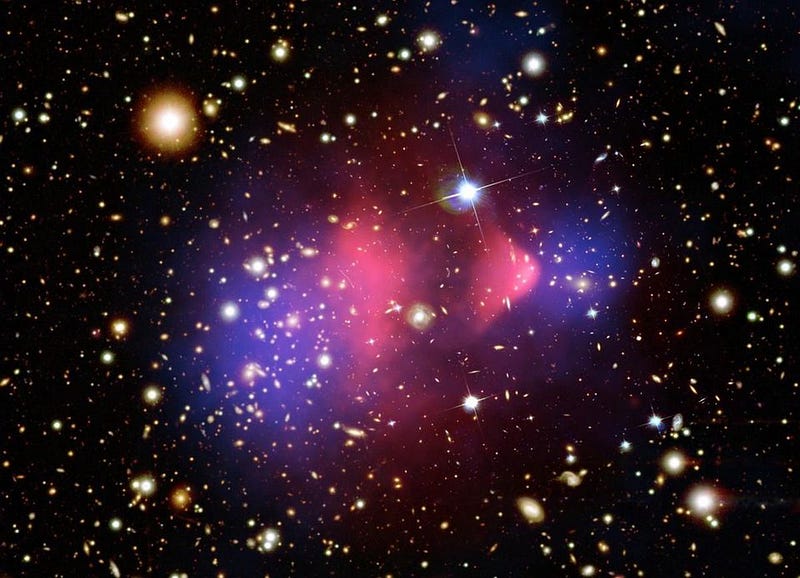
Since that time, more than a dozen other galaxy groups and clusters have been spotted colliding with one another, with each one demonstrating the same effect. Before a collision, if a cluster emits X-rays, those X-rays are associated with the cluster itself, and any gravitational distortion is found coincident with the location of the galaxies and the gas.
But after a collision, the X-ray emitting gas is offset from the matter, implying that the same physics is at play. When the clusters collide:
- the galaxies take up only a small volume inside each cluster, and pass straight through,
- the intracluster gas interacts and heats up, emitting X-rays and slowing down,
- while the dark matter, expected to occupy an enormous halo surrounding each cluster, passes through as well, affected only by gravitation.
In every colliding group and cluster we’ve observed, the same separation of X-ray gas and overall matter is seen.
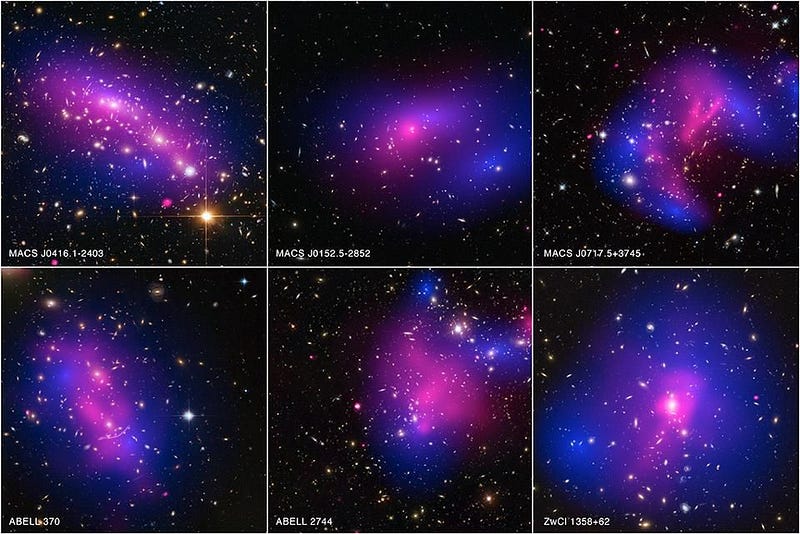
You might think that this empirical proof of dark matter, seen in so many independent systems, would sway any reasonable skeptic. Alternative theories of gravity were concocted to try to explain the misalignment between the gravitational lensing signal and the presence of matter, postulating a non-local effect that resulted in a gravitational force that was offset from the matter. But any theory that worked for one particular alignment of colliding clusters failed to explain clusters in a pre-collisional state. 15 years later, alternatives still fail to explain both configurations.
But a Universe with dark matter has a very high burden of proof: it has to explain every single observed property of these clusters. While many of these colliding groups and clusters have speeds that are predicted by a dark matter-rich Universe, the Bullet cluster — the original example — moves extremely quickly.
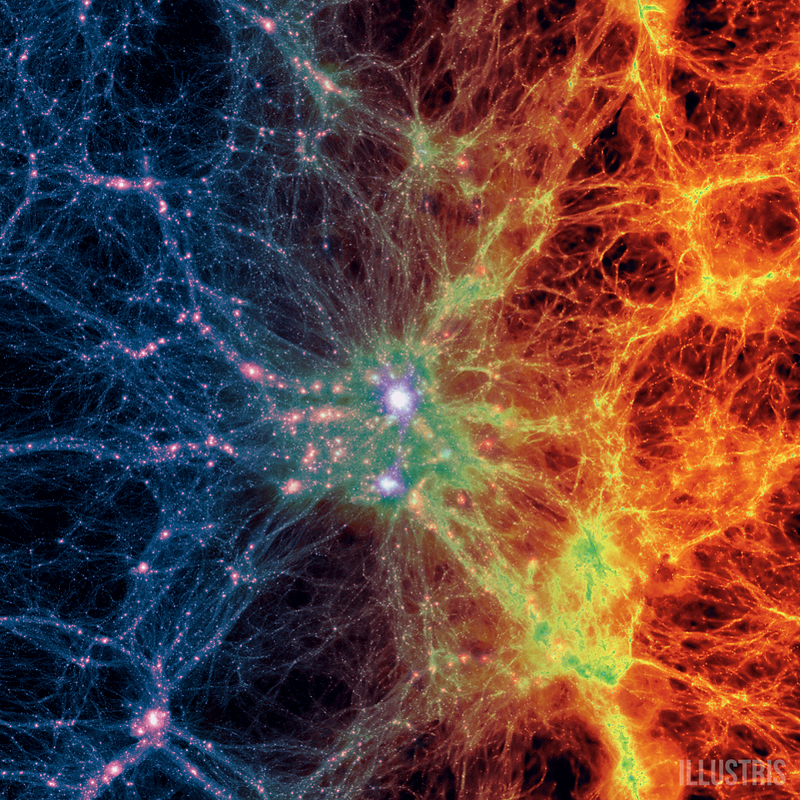
When you know the ingredients of your Universe and the laws of physics that govern what’s in it, you can run simulations to predict what types of large-scale structure emerge. When we include simulations with gravitation alone, the fastest colliding clusters we predict move slower than the Bullet cluster does; the likelihood of having a single example like it in our Universe is less than 1-in-a-million.
When we buck the cosmic odds like this, we demand an explanation. While it’s always possible that our Universe is simply a lottery-winner in terms of what’s present within it, this observation poses a legitimate problem. Either the observations were wrong, or something else — some physical mechanism — is causing this normal matter to accelerate beyond what the gravitational effects alone would indicate.
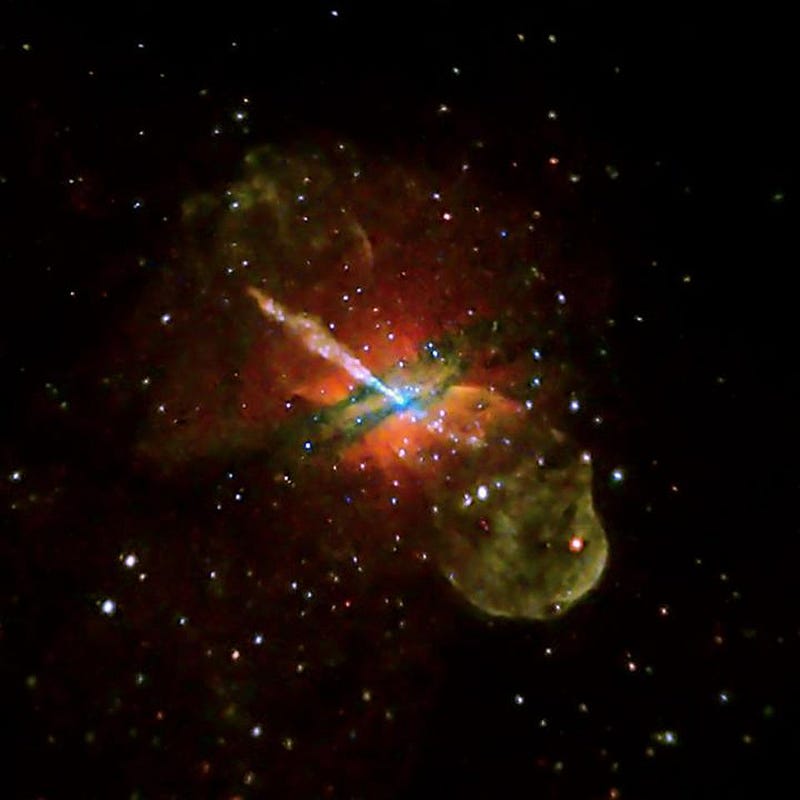
One possibility for this would be a large-scale electric or magnetic field. When charged particles (like protons and electrons, which help make up the normal matter in the Universe) encounter an electromagnetic field, they accelerate. While galaxy clusters typically form at the intersection of cosmic filaments and are driven by dark matter, there’s normal matter present as well, much of which is in the form of an ionized plasma.
Charged particles in motion must generate magnetic fields, and when objects fall into a galaxy cluster, this generates both magnetic fields and relativistic, fast-moving particles, such as electrons. When electrons move quickly in the presence of a magnetic field, they exhibit a special type of radiation known as synchrotron radiation, which could be revealed if scientists looked in the right wavelengths of light.
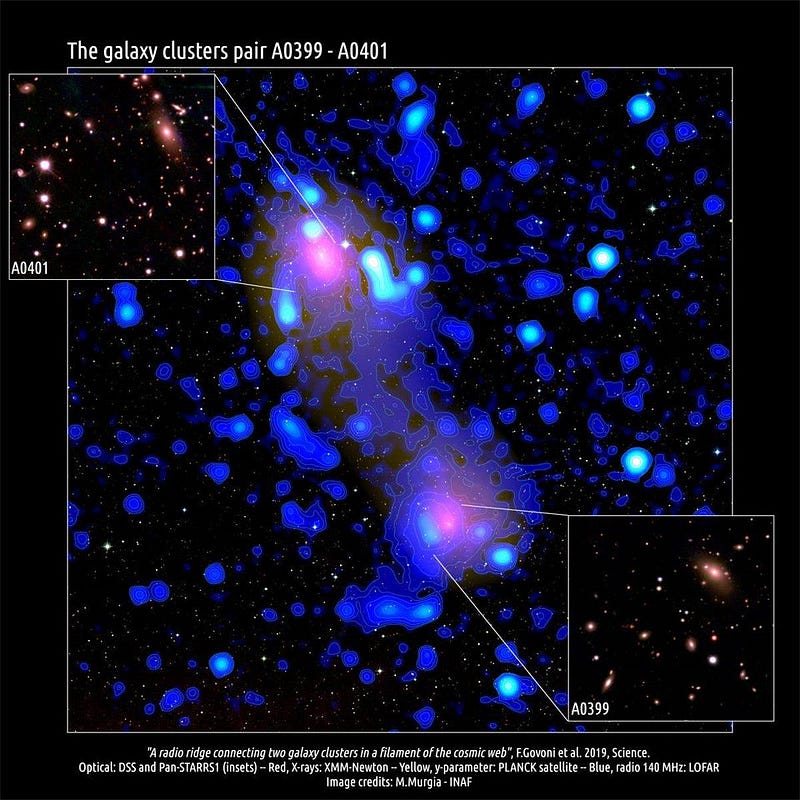
In a new study out in the June 7, 2019 issue of Science, scientists used the LOFAR radio telescope to find exactly this effect, for the first time, in a pair of colliding galaxy clusters. Federica Govoni and her colleagues used LOFAR to observe the region between the galaxy clusters Abell 0399 and Abell 0401, and detected a ridge of low-frequency radio emissions extending between them.
The emission indicates the presence of both a magnetic field connecting the two clusters and a population of relativistic electrons spanning the cosmic filament that ties them together. These two galaxy clusters are separated in space by a distance of approximately 10 million light-years, which would make this magnetic field and the electrons lining it one of the largest known such structures in the Universe.
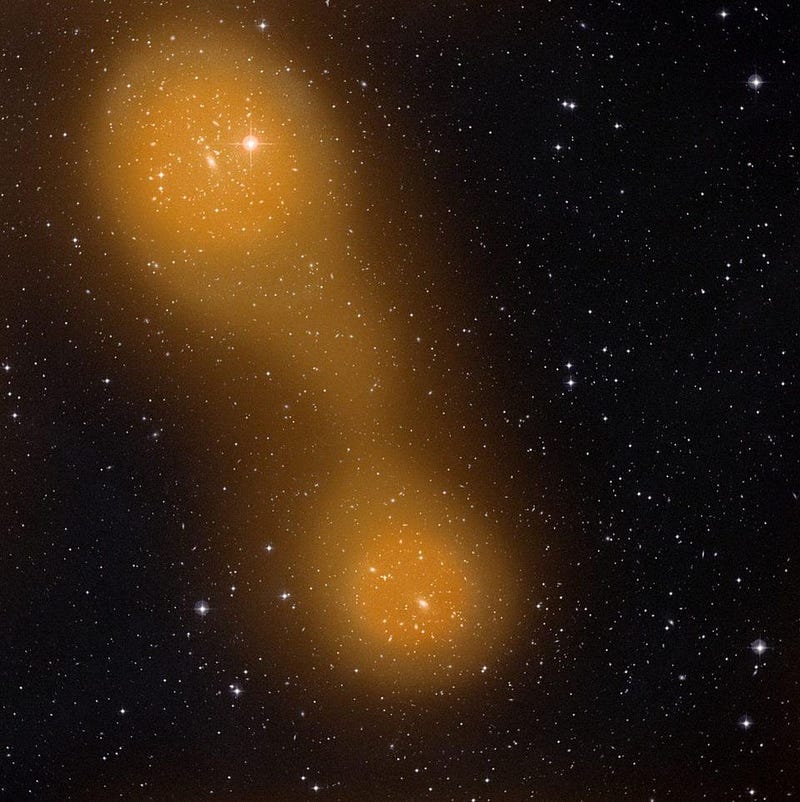
This radio ridge is also larger than most naive simulations predict, but that’s an extremely good thing for dark matter theories. The big puzzle for some of the colliding clusters we’ve observed is to explain how these particles can accelerate to such large speeds. Meanwhile, this enormous magnetic field and electron bridge between the two clusters suggests a mechanism to re-accelerate the particles present in the intergalactic gas: shock waves generated in the merger.
Govoni and her colleagues performed exactly this type of simulation. Her team showed that the electrons located between the galaxy clusters, already moving at speeds close to the speed of light, could be re-accelerated owing to these shock waves. If we apply this finding to the Bullet cluster, it stands to reason that we’d expect to find shock waves there, too, if we look at the X-ray emitting gas.
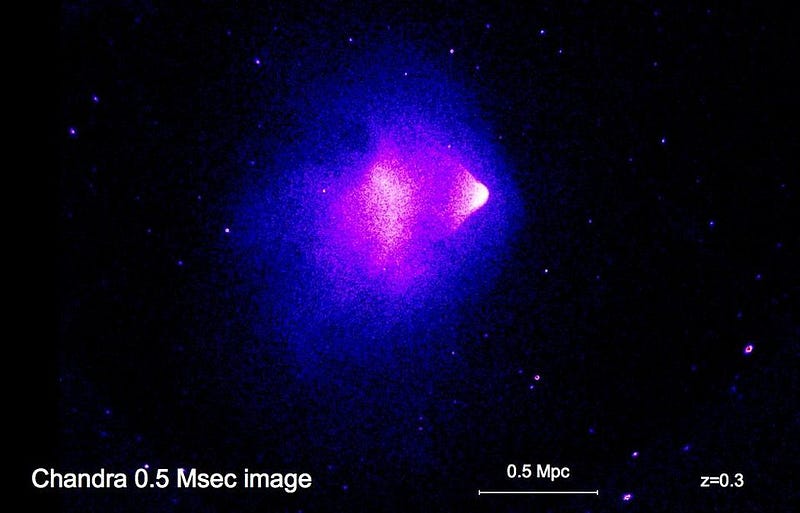
Lo and behold, these shocks are some of the first things you notice if you look at the Chandra images of the Bullet cluster on their own! The fact that we’ve identified relativistic charged particles in the presence of a large-scale magnetic field in one pair of colliding clusters is strongly suggestive of the same effects existing in other clusters. If this same type of structure that exists between Abell 0399 and Abell 0401 also exists between other colliding clusters, it could solve this minor anomaly of the Bullet cluster, leaving dark matter as the sole unchallenged explanation for the displacement of gravitational effects from the presence of normal matter.
It’s always an enormous step forward when we can identify a new phenomenon. But by combining theory, simulations, and the observations of other colliding galaxy clusters, we can push the needle forward when it comes to understanding our Universe as a whole. It’s another spectacular victory for dark matter, and another mystery of the Universe that might finally be solved by modern astrophysics. What a time to be alive.
Correction: after a Twitter exchange with one of the study’s scientists, the author regrets to inform the reader that the acceleration imparted by the magnetic fields to the electrons along this intergalactic bridge is likely unrelated to the velocity anomaly of the Bullet cluster. Although both may be explained by hydrodynamic effects, the effects that cause this radio emission and the acceleration of electrons are unrelated to the measured high velocity of the Bullet cluster’s collisional elements and X-ray gas. Ethan Siegel regrets the error.
Ethan Siegel is the author of Beyond the Galaxy and Treknology. You can pre-order his third book, currently in development: the Encyclopaedia Cosmologica.





